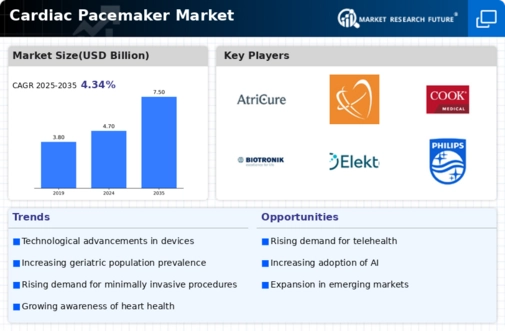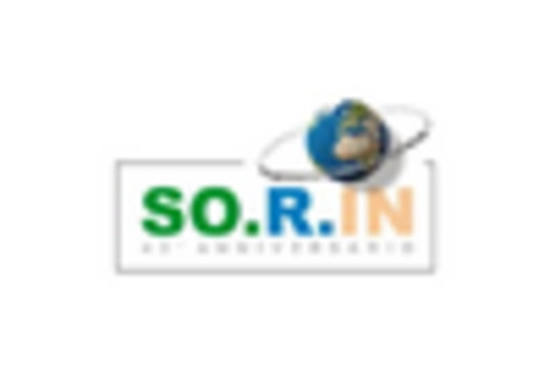Single Chamber Pacemaker
Dual Chamber Pacemaker
Biventricular Pacemaker
Bradycardia
Atrial Fibrillation
Heart Block
Hospitals
Ambulatory Surgical Centers
Home Care Settings
Transvenous Implantation
Epicardial Implantation
Leadless Implantation
North America
Europe
South America
Asia Pacific
Middle East and Africa
North America Outlook (USD Billion, 2019-2035)
North America Cardiac Pacemaker Market by Technology Type
Single Chamber Pacemaker
Dual Chamber Pacemaker
Biventricular Pacemaker
North America Cardiac Pacemaker Market by Application Type
Bradycardia
Atrial Fibrillation
Heart Block
North America Cardiac Pacemaker Market by End Use Type
Hospitals
Ambulatory Surgical Centers
Home Care Settings
North America Cardiac Pacemaker Market by Implantation Type
Transvenous Implantation
Epicardial Implantation
Leadless Implantation
North America Cardiac Pacemaker Market by Regional Type
US
Canada
US Outlook (USD Billion, 2019-2035)
US Cardiac Pacemaker Market by Technology Type
Single Chamber Pacemaker
Dual Chamber Pacemaker
Biventricular Pacemaker
US Cardiac Pacemaker Market by Application Type
Bradycardia
Atrial Fibrillation
Heart Block
US Cardiac Pacemaker Market by End Use Type
Hospitals
Ambulatory Surgical Centers
Home Care Settings
US Cardiac Pacemaker Market by Implantation Type
Transvenous Implantation
Epicardial Implantation
Leadless Implantation
CANADA Outlook (USD Billion, 2019-2035)
CANADA Cardiac Pacemaker Market by Technology Type
Single Chamber Pacemaker
Dual Chamber Pacemaker
Biventricular Pacemaker
CANADA Cardiac Pacemaker Market by Application Type
Bradycardia
Atrial Fibrillation
Heart Block
CANADA Cardiac Pacemaker Market by End Use Type
Hospitals
Ambulatory Surgical Centers
Home Care Settings
CANADA Cardiac Pacemaker Market by Implantation Type
Transvenous Implantation
Epicardial Implantation
Leadless Implantation
Europe Outlook (USD Billion, 2019-2035)
Europe Cardiac Pacemaker Market by Technology Type
Single Chamber Pacemaker
Dual Chamber Pacemaker
Biventricular Pacemaker
Europe Cardiac Pacemaker Market by Application Type
Bradycardia
Atrial Fibrillation
Heart Block
Europe Cardiac Pacemaker Market by End Use Type
Hospitals
Ambulatory Surgical Centers
Home Care Settings
Europe Cardiac Pacemaker Market by Implantation Type
Transvenous Implantation
Epicardial Implantation
Leadless Implantation
Europe Cardiac Pacemaker Market by Regional Type
Germany
UK
France
Russia
Italy
Spain
Rest of Europe
GERMANY Outlook (USD Billion, 2019-2035)
GERMANY Cardiac Pacemaker Market by Technology Type
Single Chamber Pacemaker
Dual Chamber Pacemaker
Biventricular Pacemaker
GERMANY Cardiac Pacemaker Market by Application Type
Bradycardia
Atrial Fibrillation
Heart Block
GERMANY Cardiac Pacemaker Market by End Use Type
Hospitals
Ambulatory Surgical Centers
Home Care Settings
GERMANY Cardiac Pacemaker Market by Implantation Type
Transvenous Implantation
Epicardial Implantation
Leadless Implantation
UK Outlook (USD Billion, 2019-2035)
UK Cardiac Pacemaker Market by Technology Type
Single Chamber Pacemaker
Dual Chamber Pacemaker
Biventricular Pacemaker
UK Cardiac Pacemaker Market by Application Type
Bradycardia
Atrial Fibrillation
Heart Block
UK Cardiac Pacemaker Market by End Use Type
Hospitals
Ambulatory Surgical Centers
Home Care Settings
UK Cardiac Pacemaker Market by Implantation Type
Transvenous Implantation
Epicardial Implantation
Leadless Implantation
FRANCE Outlook (USD Billion, 2019-2035)
FRANCE Cardiac Pacemaker Market by Technology Type
Single Chamber Pacemaker
Dual Chamber Pacemaker
Biventricular Pacemaker
FRANCE Cardiac Pacemaker Market by Application Type
Bradycardia
Atrial Fibrillation
Heart Block
FRANCE Cardiac Pacemaker Market by End Use Type
Hospitals
Ambulatory Surgical Centers
Home Care Settings
FRANCE Cardiac Pacemaker Market by Implantation Type
Transvenous Implantation
Epicardial Implantation
Leadless Implantation
RUSSIA Outlook (USD Billion, 2019-2035)
RUSSIA Cardiac Pacemaker Market by Technology Type
Single Chamber Pacemaker
Dual Chamber Pacemaker
Biventricular Pacemaker
RUSSIA Cardiac Pacemaker Market by Application Type
Bradycardia
Atrial Fibrillation
Heart Block
RUSSIA Cardiac Pacemaker Market by End Use Type
Hospitals
Ambulatory Surgical Centers
Home Care Settings
RUSSIA Cardiac Pacemaker Market by Implantation Type
Transvenous Implantation
Epicardial Implantation
Leadless Implantation
ITALY Outlook (USD Billion, 2019-2035)
ITALY Cardiac Pacemaker Market by Technology Type
Single Chamber Pacemaker
Dual Chamber Pacemaker
Biventricular Pacemaker
ITALY Cardiac Pacemaker Market by Application Type
Bradycardia
Atrial Fibrillation
Heart Block
ITALY Cardiac Pacemaker Market by End Use Type
Hospitals
Ambulatory Surgical Centers
Home Care Settings
ITALY Cardiac Pacemaker Market by Implantation Type
Transvenous Implantation
Epicardial Implantation
Leadless Implantation
SPAIN Outlook (USD Billion, 2019-2035)
SPAIN Cardiac Pacemaker Market by Technology Type
Single Chamber Pacemaker
Dual Chamber Pacemaker
Biventricular Pacemaker
SPAIN Cardiac Pacemaker Market by Application Type
Bradycardia
Atrial Fibrillation
Heart Block
SPAIN Cardiac Pacemaker Market by End Use Type
Hospitals
Ambulatory Surgical Centers
Home Care Settings
SPAIN Cardiac Pacemaker Market by Implantation Type
Transvenous Implantation
Epicardial Implantation
Leadless Implantation
REST OF EUROPE Outlook (USD Billion, 2019-2035)
REST OF EUROPE Cardiac Pacemaker Market by Technology Type
Single Chamber Pacemaker
Dual Chamber Pacemaker
Biventricular Pacemaker
REST OF EUROPE Cardiac Pacemaker Market by Application Type
Bradycardia
Atrial Fibrillation
Heart Block
REST OF EUROPE Cardiac Pacemaker Market by End Use Type
Hospitals
Ambulatory Surgical Centers
Home Care Settings
REST OF EUROPE Cardiac Pacemaker Market by Implantation Type
Transvenous Implantation
Epicardial Implantation
Leadless Implantation
APAC Outlook (USD Billion, 2019-2035)
APAC Cardiac Pacemaker Market by Technology Type
Single Chamber Pacemaker
Dual Chamber Pacemaker
Biventricular Pacemaker
APAC Cardiac Pacemaker Market by Application Type
Bradycardia
Atrial Fibrillation
Heart Block
APAC Cardiac Pacemaker Market by End Use Type
Hospitals
Ambulatory Surgical Centers
Home Care Settings
APAC Cardiac Pacemaker Market by Implantation Type
Transvenous Implantation
Epicardial Implantation
Leadless Implantation
APAC Cardiac Pacemaker Market by Regional Type
China
India
Japan
South Korea
Malaysia
Thailand
Indonesia
Rest of APAC
CHINA Outlook (USD Billion, 2019-2035)
CHINA Cardiac Pacemaker Market by Technology Type
Single Chamber Pacemaker
Dual Chamber Pacemaker
Biventricular Pacemaker
CHINA Cardiac Pacemaker Market by Application Type
Bradycardia
Atrial Fibrillation
Heart Block
CHINA Cardiac Pacemaker Market by End Use Type
Hospitals
Ambulatory Surgical Centers
Home Care Settings
CHINA Cardiac Pacemaker Market by Implantation Type
Transvenous Implantation
Epicardial Implantation
Leadless Implantation
INDIA Outlook (USD Billion, 2019-2035)
INDIA Cardiac Pacemaker Market by Technology Type
Single Chamber Pacemaker
Dual Chamber Pacemaker
Biventricular Pacemaker
INDIA Cardiac Pacemaker Market by Application Type
Bradycardia
Atrial Fibrillation
Heart Block
INDIA Cardiac Pacemaker Market by End Use Type
Hospitals
Ambulatory Surgical Centers
Home Care Settings
INDIA Cardiac Pacemaker Market by Implantation Type
Transvenous Implantation
Epicardial Implantation
Leadless Implantation
JAPAN Outlook (USD Billion, 2019-2035)
JAPAN Cardiac Pacemaker Market by Technology Type
Single Chamber Pacemaker
Dual Chamber Pacemaker
Biventricular Pacemaker
JAPAN Cardiac Pacemaker Market by Application Type
Bradycardia
Atrial Fibrillation
Heart Block
JAPAN Cardiac Pacemaker Market by End Use Type
Hospitals
Ambulatory Surgical Centers
Home Care Settings
JAPAN Cardiac Pacemaker Market by Implantation Type
Transvenous Implantation
Epicardial Implantation
Leadless Implantation
SOUTH KOREA Outlook (USD Billion, 2019-2035)
SOUTH KOREA Cardiac Pacemaker Market by Technology Type
Single Chamber Pacemaker
Dual Chamber Pacemaker
Biventricular Pacemaker
SOUTH KOREA Cardiac Pacemaker Market by Application Type
Bradycardia
Atrial Fibrillation
Heart Block
SOUTH KOREA Cardiac Pacemaker Market by End Use Type
Hospitals
Ambulatory Surgical Centers
Home Care Settings
SOUTH KOREA Cardiac Pacemaker Market by Implantation Type
Transvenous Implantation
Epicardial Implantation
Leadless Implantation
MALAYSIA Outlook (USD Billion, 2019-2035)
MALAYSIA Cardiac Pacemaker Market by Technology Type
Single Chamber Pacemaker
Dual Chamber Pacemaker
Biventricular Pacemaker
MALAYSIA Cardiac Pacemaker Market by Application Type
Bradycardia
Atrial Fibrillation
Heart Block
MALAYSIA Cardiac Pacemaker Market by End Use Type
Hospitals
Ambulatory Surgical Centers
Home Care Settings
MALAYSIA Cardiac Pacemaker Market by Implantation Type
Transvenous Implantation
Epicardial Implantation
Leadless Implantation
THAILAND Outlook (USD Billion, 2019-2035)
THAILAND Cardiac Pacemaker Market by Technology Type
Single Chamber Pacemaker
Dual Chamber Pacemaker
Biventricular Pacemaker
THAILAND Cardiac Pacemaker Market by Application Type
Bradycardia
Atrial Fibrillation
Heart Block
THAILAND Cardiac Pacemaker Market by End Use Type
Hospitals
Ambulatory Surgical Centers
Home Care Settings
THAILAND Cardiac Pacemaker Market by Implantation Type
Transvenous Implantation
Epicardial Implantation
Leadless Implantation
INDONESIA Outlook (USD Billion, 2019-2035)
INDONESIA Cardiac Pacemaker Market by Technology Type
Single Chamber Pacemaker
Dual Chamber Pacemaker
Biventricular Pacemaker
INDONESIA Cardiac Pacemaker Market by Application Type
Bradycardia
Atrial Fibrillation
Heart Block
INDONESIA Cardiac Pacemaker Market by End Use Type
Hospitals
Ambulatory Surgical Centers
Home Care Settings
INDONESIA Cardiac Pacemaker Market by Implantation Type
Transvenous Implantation
Epicardial Implantation
Leadless Implantation
REST OF APAC Outlook (USD Billion, 2019-2035)
REST OF APAC Cardiac Pacemaker Market by Technology Type
Single Chamber Pacemaker
Dual Chamber Pacemaker
Biventricular Pacemaker
REST OF APAC Cardiac Pacemaker Market by Application Type
Bradycardia
Atrial Fibrillation
Heart Block
REST OF APAC Cardiac Pacemaker Market by End Use Type
Hospitals
Ambulatory Surgical Centers
Home Care Settings
REST OF APAC Cardiac Pacemaker Market by Implantation Type
Transvenous Implantation
Epicardial Implantation
Leadless Implantation
South America Outlook (USD Billion, 2019-2035)
South America Cardiac Pacemaker Market by Technology Type
Single Chamber Pacemaker
Dual Chamber Pacemaker
Biventricular Pacemaker
South America Cardiac Pacemaker Market by Application Type
Bradycardia
Atrial Fibrillation
Heart Block
South America Cardiac Pacemaker Market by End Use Type
Hospitals
Ambulatory Surgical Centers
Home Care Settings
South America Cardiac Pacemaker Market by Implantation Type
Transvenous Implantation
Epicardial Implantation
Leadless Implantation
South America Cardiac Pacemaker Market by Regional Type
Brazil
Mexico
Argentina
Rest of South America
BRAZIL Outlook (USD Billion, 2019-2035)
BRAZIL Cardiac Pacemaker Market by Technology Type
Single Chamber Pacemaker
Dual Chamber Pacemaker
Biventricular Pacemaker
BRAZIL Cardiac Pacemaker Market by Application Type
Bradycardia
Atrial Fibrillation
Heart Block
BRAZIL Cardiac Pacemaker Market by End Use Type
Hospitals
Ambulatory Surgical Centers
Home Care Settings
BRAZIL Cardiac Pacemaker Market by Implantation Type
Transvenous Implantation
Epicardial Implantation
Leadless Implantation
MEXICO Outlook (USD Billion, 2019-2035)
MEXICO Cardiac Pacemaker Market by Technology Type
Single Chamber Pacemaker
Dual Chamber Pacemaker
Biventricular Pacemaker
MEXICO Cardiac Pacemaker Market by Application Type
Bradycardia
Atrial Fibrillation
Heart Block
MEXICO Cardiac Pacemaker Market by End Use Type
Hospitals
Ambulatory Surgical Centers
Home Care Settings
MEXICO Cardiac Pacemaker Market by Implantation Type
Transvenous Implantation
Epicardial Implantation
Leadless Implantation
ARGENTINA Outlook (USD Billion, 2019-2035)
ARGENTINA Cardiac Pacemaker Market by Technology Type
Single Chamber Pacemaker
Dual Chamber Pacemaker
Biventricular Pacemaker
ARGENTINA Cardiac Pacemaker Market by Application Type
Bradycardia
Atrial Fibrillation
Heart Block
ARGENTINA Cardiac Pacemaker Market by End Use Type
Hospitals
Ambulatory Surgical Centers
Home Care Settings
ARGENTINA Cardiac Pacemaker Market by Implantation Type
Transvenous Implantation
Epicardial Implantation
Leadless Implantation
REST OF SOUTH AMERICA Outlook (USD Billion, 2019-2035)
REST OF SOUTH AMERICA Cardiac Pacemaker Market by Technology Type
Single Chamber Pacemaker
Dual Chamber Pacemaker
Biventricular Pacemaker
REST OF SOUTH AMERICA Cardiac Pacemaker Market by Application Type
Bradycardia
Atrial Fibrillation
Heart Block
REST OF SOUTH AMERICA Cardiac Pacemaker Market by End Use Type
Hospitals
Ambulatory Surgical Centers
Home Care Settings
REST OF SOUTH AMERICA Cardiac Pacemaker Market by Implantation Type
Transvenous Implantation
Epicardial Implantation
Leadless Implantation
MEA Outlook (USD Billion, 2019-2035)
MEA Cardiac Pacemaker Market by Technology Type
Single Chamber Pacemaker
Dual Chamber Pacemaker
Biventricular Pacemaker
MEA Cardiac Pacemaker Market by Application Type
Bradycardia
Atrial Fibrillation
Heart Block
MEA Cardiac Pacemaker Market by End Use Type
Hospitals
Ambulatory Surgical Centers
Home Care Settings
MEA Cardiac Pacemaker Market by Implantation Type
Transvenous Implantation
Epicardial Implantation
Leadless Implantation
MEA Cardiac Pacemaker Market by Regional Type
GCC Countries
South Africa
Rest of MEA
GCC COUNTRIES Outlook (USD Billion, 2019-2035)
GCC COUNTRIES Cardiac Pacemaker Market by Technology Type
Single Chamber Pacemaker
Dual Chamber Pacemaker
Biventricular Pacemaker
GCC COUNTRIES Cardiac Pacemaker Market by Application Type
Bradycardia
Atrial Fibrillation
Heart Block
GCC COUNTRIES Cardiac Pacemaker Market by End Use Type
Hospitals
Ambulatory Surgical Centers
Home Care Settings
GCC COUNTRIES Cardiac Pacemaker Market by Implantation Type
Transvenous Implantation
Epicardial Implantation
Leadless Implantation
SOUTH AFRICA Outlook (USD Billion, 2019-2035)
SOUTH AFRICA Cardiac Pacemaker Market by Technology Type
Single Chamber Pacemaker
Dual Chamber Pacemaker
Biventricular Pacemaker
SOUTH AFRICA Cardiac Pacemaker Market by Application Type
Bradycardia
Atrial Fibrillation
Heart Block
SOUTH AFRICA Cardiac Pacemaker Market by End Use Type
Hospitals
Ambulatory Surgical Centers
Home Care Settings
SOUTH AFRICA Cardiac Pacemaker Market by Implantation Type
Transvenous Implantation
Epicardial Implantation
Leadless Implantation
REST OF MEA Outlook (USD Billion, 2019-2035)
REST OF MEA Cardiac Pacemaker Market by Technology Type
Single Chamber Pacemaker
Dual Chamber Pacemaker
Biventricular Pacemaker
REST OF MEA Cardiac Pacemaker Market by Application Type
Bradycardia
Atrial Fibrillation
Heart Block
REST OF MEA Cardiac Pacemaker Market by End Use Type
Hospitals
Ambulatory Surgical Centers
Home Care Settings
REST OF MEA Cardiac Pacemaker Market by Implantation Type
Transvenous Implantation
Epicardial Implantation
Leadless Implantation










Leave a Comment